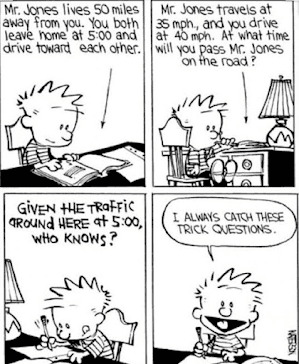Rate and Ratio on the ACT® Math: The Complete Guide
Read time: 4 minutes Last updated: September 23rd, 2024
Rates and ratios are fundamental concepts in mathematics that frequently appear on the ACT® Math section. Understanding these how to apply these concepts will help you score more points on the ACT®. Let's looks at what rates and ratios are and how they show up on the ACT®.
Rates
A rate is a comparison between two quantities with different units. The ACT® often includes rate problems, though they may not always be as straightforward as the classic "two trains" scenario.

Consider this example:
Question:
Bethany is your friend. She lives 10 minutes away if you're going 30 mph. Your car breaks down. Given the average human walking speed is 5 mph. How long will it take you to walk to Bethany's house?
Click for the Answer
Let's break this down step-by-step:
First, we need to find the distance to Bethany's house:
Distance = Speed × Time
Distance = 30 mph × (10/60) hours = 5 miles
Now that we know the distance, we can calculate the time it takes to walk:
Time = Distance ÷ Speed
Time = 5 miles ÷ 5 mph = 1 hour
So, it will take you 1 hour to walk to Bethany's house.
Question:
You need 10 inches of fabric to make a pillow case. You plan to make 8 pillow cases. How many yards of fabric do you need?
Click for the Answer
First, calculate the total inches needed:
Total inches = 10 inches × 8 = 80 inches
Convert inches to yards (1 yard = 36 inches):
Total yards = 80 inches / 36 inches/yard ≈ 2.22 yards
Ratios
A ratio is a comparison between two quantities with the same unit. Here's a typical ACT® Math question about ratios:
Question:
The ratio of juniors to freshmen is 2:3. Given there are 800 students in those grades, how many are freshmen?
Click for the Answer
Let's break this down step-by-step:
- Understand the given information:
- The ratio of juniors to freshmen is 2:3
- There are 800 students total in these two grades
- Set up the equation:
Let x represent one part of the ratio
Juniors: 2x
Freshmen: 3x
Total: 2x + 3x = 5x = 800
- Solve for x:
5x = 800
x = 800 ÷ 5 = 160
- Calculate the number of freshmen:
Freshmen = 3x = 3 × 160 = 480
- Check our work:
Juniors: 2x = 2 × 160 = 320
Total: 480 + 320 = 800 (matches our given total)
Therefore, there are 480 freshmen.
More Practice
Question:
5 lbs makes 210 servings, how many lbs makes 70 servings?
Click for the Answer
Set up a proportion to solve for the unknown weight:
(5 lbs)/(210 servings) = (x lbs)/(70 servings)
Cross-multiply and solve for x:
5 · 70 = 210x
350 = 210x
x = 350/210 ≈ 1.67 lbs
Applying What We've Learned
Let's look at a couple more examples to reinforce our understanding of rates and ratios:
Example 1:
If 6 pencils cost $1.50, how much do 4 pencils cost?
Click for the Answer
Set up a proportion to solve for the unknown cost:
(6 pencils)/(1.50 dollars) = (4 pencils)/(x dollars)
Cross-multiply and solve for x:
6x = 1.50 · 4
6x = 6
x = 6/6 = 1 dollar
Example 2:
The ratio of cats to dogs in a shelter is 3:4. If there are 28 dogs, how many cats are there?
Click for the Answer
Set up a proportion to solve for the number of cats:
(3 cats)/(4 dogs) = (x cats)/(28 dogs)
Cross-multiply and solve for x:
4x = 3 × 28
4x = 84
x = 84/4 = 21 cats
Conclusion
Rates and ratios are essential concepts in ACT® Math. A rate compares quantities with different units (like miles per hour), while a ratio compares quantities with the same unit (like the number of students in different grades). Practice identifying these types of problems and applying the strategies we've discussed to solve them efficiently.
